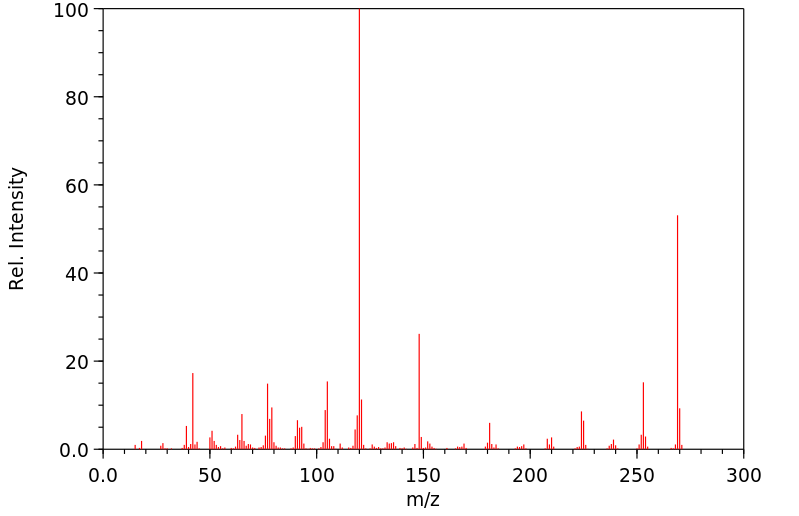| Name: | Methyl Red reagent ACS Material Safety Data Sheet |
| Synonym: | C.I. Acid Red 2; 2-(4-Dimethylaminophenylazo)benzoic acid; C.I. 13020; p-(Dimethylamino)azobenzene-o-carboxylic acid; Methyl Red |
| CAS: | 493-52-7 |
Section 1 - Chemical Product MSDS Name:Methyl Red reagent ACS Material Safety Data Sheet
Synonym:C.I. Acid Red 2; 2-(4-Dimethylaminophenylazo)benzoic acid; C.I. 13020; p-(Dimethylamino)azobenzene-o-carboxylic acid; Methyl Red
Section 2 - COMPOSITION, INFORMATION ON INGREDIENTS | CAS# | Chemical Name | content | EINECS# |
| 493-52-7 | Methyl Red | 98 | 207-776-1 |
Hazard Symbols: None Listed.
Risk Phrases: None Listed.
Section 3 - HAZARDS IDENTIFICATION EMERGENCY OVERVIEW
Not available.
Potential Health Effects
Eye:
Contact may cause transient eye irritation. This product contains an anionic dye. Similar dyes have not caused injury to the cornea or conjunctiva in documented exposure cases with human or rabbit eyes.
Skin:
May cause skin irritation.
Ingestion:
May cause irritation of the digestive tract. The toxicological properties of this substance have not been fully investigated.
Inhalation:
May cause respiratory tract irritation. The toxicological properties of this substance have not been fully investigated.
Chronic:
Chronic exposure may cause liver damage.
Section 4 - FIRST AID MEASURES Eyes: In case of contact, immediately flush eyes with plenty of water for at least 15 minutes. Get medical aid.
Skin:
In case of contact, flush skin with plenty of water. Remove contaminated clothing and shoes. Get medical aid if irritation develops and persists. Wash clothing before reuse.
Ingestion:
If swallowed, do not induce vomiting unless directed to do so by medical personnel. Never give anything by mouth to an unconscious person. Get medical aid.
Inhalation:
If inhaled, remove to fresh air. If not breathing, give artificial respiration. If breathing is difficult, give oxygen. Get medical aid.
Notes to Physician:
Section 5 - FIRE FIGHTING MEASURES General Information:
As in any fire, wear a self-contained breathing apparatus in pressure-demand, MSHA/NIOSH (approved or equivalent), and full protective gear. Combustion generates toxic fumes. This material in sufficient quantity and reduced particle size is capable of creating a dust explosion.
Extinguishing Media:
For small fires, use water spray, dry chemical, carbon dioxide or chemical foam.
Section 6 - ACCIDENTAL RELEASE MEASURES General Information: Use proper personal protective equipment as indicated in Section 8.
Spills/Leaks:
Clean up spills immediately, observing precautions in the Protective Equipment section. Sweep up, then place into a suitable container for disposal. Avoid generating dusty conditions. Provide ventilation.
Section 7 - HANDLING and STORAGE Handling:
Wash thoroughly after handling. Use with adequate ventilation.
Minimize dust generation and accumulation. Avoid contact with eyes, skin, and clothing. Avoid ingestion and inhalation.
Storage:
Store in a cool, dry, well-ventilated area away from incompatible substances.
Section 8 - EXPOSURE CONTROLS, PERSONAL PROTECTION Engineering Controls:
Facilities storing or utilizing this material should be equipped with an eyewash facility and a safety shower. Use adequate ventilation to keep airborne concentrations low.
Exposure Limits CAS# 493-52-7: Personal Protective Equipment Eyes: Wear appropriate protective eyeglasses or chemical safety goggles as described by OSHA's eye and face protection regulations in 29 CFR 1910.133 or European Standard EN166.
Skin:
Wear appropriate protective gloves to prevent skin exposure.
Clothing:
Wear appropriate protective clothing to minimize contact with skin.
Respirators:
Follow the OSHA respirator regulations found in 29 CFR 1910.134 or European Standard EN 149. Use a NIOSH/MSHA or European Standard EN 149 approved respirator if exposure limits are exceeded or if irritation or other symptoms are experienced.
Section 9 - PHYSICAL AND CHEMICAL PROPERTIES Physical State: Solid
Color: dark red to purple
Odor: none reported
pH: Not available.
Vapor Pressure: Negliglble.
Viscosity: Not available.
Boiling Point: Not available.
Freezing/Melting Point: 179-182 deg C
Autoignition Temperature: Not applicable.
Flash Point: Not applicable.
Explosion Limits, lower: Not available.
Explosion Limits, upper: Not available.
Decomposition Temperature: Not available.
Solubility in water: Insoluble in water.
Specific Gravity/Density: Not available.
Molecular Formula: C15H15N3O2
Molecular Weight: 269.30
Section 10 - STABILITY AND REACTIVITY Chemical Stability:
Stable under normal temperatures and pressures. Materials containing similar functional groups can decompose at elevated temperatures.
Conditions to Avoid:
Dust generation, excess heat.
Incompatibilities with Other Materials:
Strong oxidizing agents.
Hazardous Decomposition Products:
Nitrogen oxides, carbon monoxide, carbon dioxide.
Hazardous Polymerization: Has not been reported.
Section 11 - TOXICOLOGICAL INFORMATION RTECS#:
CAS# 493-52-7: DG8960000 LD50/LC50:
Not available.
Carcinogenicity:
Methyl Red - Not listed by ACGIH, IARC, or NTP.
Other:
See actual entry in RTECS for complete information.
Section 12 - ECOLOGICAL INFORMATION
Section 13 - DISPOSAL CONSIDERATIONS Dispose of in a manner consistent with federal, state, and local regulations.
Section 14 - TRANSPORT INFORMATION IATA
Shipping Name: Not regulated.
Hazard Class:
UN Number:
Packing Group:
IMO
Shipping Name: Not regulated.
Hazard Class:
UN Number:
Packing Group:
RID/ADR
Shipping Name: Not regulated.
Hazard Class:
UN Number:
Packing group:
Section 15 - REGULATORY INFORMATION European/International Regulations
European Labeling in Accordance with EC Directives
Hazard Symbols: Not available.
Risk Phrases:
Safety Phrases:
S 24/25 Avoid contact with skin and eyes.
WGK (Water Danger/Protection)
CAS# 493-52-7: 2
Canada
CAS# 493-52-7 is listed on Canada's DSL List.
CAS# 493-52-7 is not listed on Canada's Ingredient Disclosure List.
US FEDERAL
TSCA
CAS# 493-52-7 is listed on the TSCA inventory.
SECTION 16 - ADDITIONAL INFORMATION N/A







